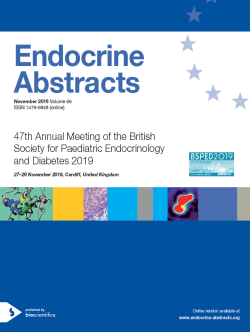
47th Meeting of the British Society for Paediatric Endocrinology and Diabetes
Cardiff,
UK
27 Nov 2019 - 29 Nov 2019

ORAL COMMUNICATIONS
Oral Communications 5
ea0066oc5.1 | Oral Communications 5 | BSPED2019
Project to develop BSPED UK standardised guidelines for sex hormone priming and glucagon stimulation testing (GST) in children and adolescents
Wei Christina , Musson Pauline , Clayton Peter , Dattani Mehul , Randell Tabitha , Crowne Elizabeth C
ea0066oc5.2 | Oral Communications 5 | BSPED2019
Longitudinal outcomes of well, term infants who present with persistent hyperthyrotropinaemia
Ng Sze May , Oryan Tal , Katkat Nancy , Ayoede Kayode , Aleem Mahreen
ea0066oc5.3 | Oral Communications 5 | BSPED2019
Causes of central diabetes insipidus in children: a single-centre experience
Arya Ved Bhushan , Korkmaz Huseyin Anil , Kalitsi Jennifer , Kapoor Ritika R , Buchanan Charles R
ea0066oc5.4 | Oral Communications 5 | BSPED2019
Tolvaptan for hyponatraemia in infants with brain tumours
Gopal-Kothandapani Jaya Sujatha , Bockenhauer Detlef , Spoudeas Helen
ea0066oc5.5 | Oral Communications 5 | BSPED2019
Recombinant human Insulin-like growth factor-1 (rhIGF-1) therapy: a 15-year experience in a tertiary care centre
Aftab Sommayya , Prentice Philippa , Katugampola Harshini , Dattani Mehul
ea0066oc5.6 | Oral Communications 5 | BSPED2019
Monitoring and long-term disease activity in children with X-linked hypophosphataemia on conventional therapy
Uday Suma , Shaw Nick , Mughal Zulf , Randell Tabitha , Hogler Wolfgang , Santos Rui , Padidela Raja
ea0066oc5.7 | Oral Communications 5 | BSPED2019
Longitudinal changes in external masculinisation scores in boys born with XY disorders of sex development
Kraria Loubna , Alimussina Malika , Ahmed S Faisal
ea0066oc5.8 | Oral Communications 5 | BSPED2019
TSH-Receptor testing in pregnancy allows stratification of risk of neonatal thyrotoxicosis and promotes earlier discharge
Law James , Chauhan Hemma , Wynn-Davies Anneli
ea0066oc5.9 | Oral Communications 5 | BSPED2019
Rare causes of primary adrenal insufficiency (PAI) in children from Sudan
Qamar Younus , Maharaj Avinaash , Chan Li , AbdulBagi S , Abdullah M , Metherell Louise
ea0066oc5.10 | Oral Communications 5 | BSPED2019
Review of neonatal cortisol evaluation between 2012–2018 in a single centre: trends, outcomes and associations
Makaya Taffy , Sarvasiddhi Satish , van Boxel Elizabeth , Menon Smrithi , Shine Brian



